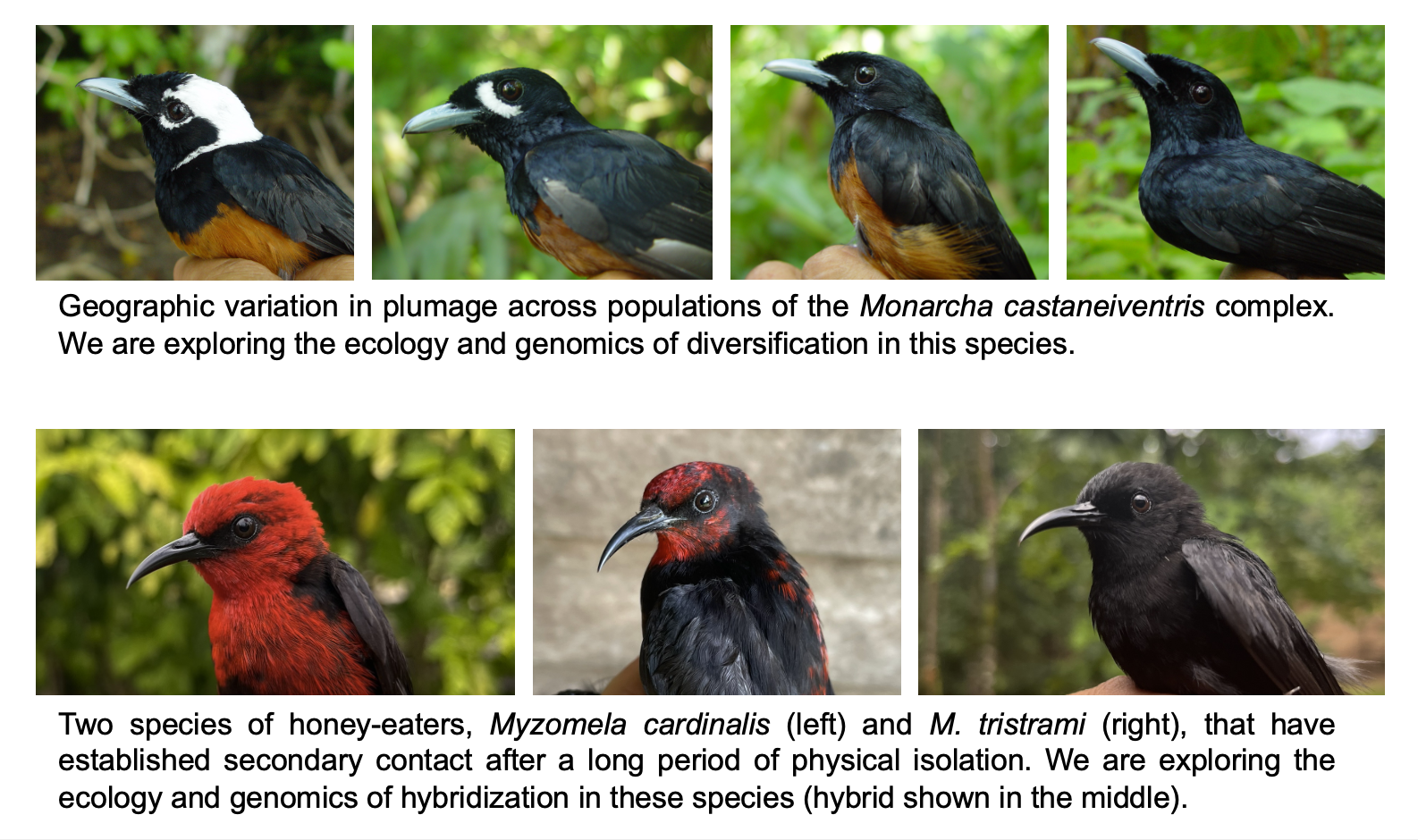
J. Albert C. Uy
Dean's Professor
Professor of Biology
Interim Dean of the School of Arts & Sciences
PhD
Research Active
Now accepting:
PhD students
Please email with inquiries.
- Office Location
- 342 Hutchison
- Telephone
- (585) 273-1309
- al.uy@rochester.edu
- Web Address
- Website
Office Hours: By appointment
Research Overview
For nearly two decades, our research has focused on understanding the origin and maintenance of biological diversity in the tropics, the cradle of our planet’s diversity. Our work explores how populations change to adapt to their physical and social environments, and how these changes, in turn, can result in reproductive barriers. To this end, my research group explores two major foci. First, we explore how changes in the ways animals communicate can lead to reproductive barriers between populations — the hallmark of biological species. For instance, we explore how changes in plumage color and song in birds, which are traits used in choosing and competing for mates, can result in premating reproductive barriers between populations. Second, we explore how populations change to more effectively exploit their biotic and abiotic environments, and how these changes can likewise lead to reproductive barriers and the maintenance of species boundaries. We explore, for example, how novel environments, including urbanization, drive changes for more efficient feeding and communication.
For both foci, we take advantage of species with populations currently adapting to their environment and/or are on the verge of becoming new species. In these projects, we use an integrative approach to determine the molecular basis and genomic consequences of adaptive change by combining long-term field observations and experiments with cutting-edge approaches in genomics, proteomics, and developmental biology.

To learn more about our research, please visit our lab website.
Research Interests
- Evolutionary Ecology
- Behavioral Ecology
- Evolutionary Genetics
- Speciation
- Conservation
Selected Publications
- Ocampo, D., K. Winker, M.J. Miller, L. Sandoval & J.A.C. Uy. 2023. Replicate contact zones suggest a limited role of plumage in reproductive isolation among subspecies of the Variable Seedeater (Sporophila corvina). Molecular Ecology. 32:3586–3604.
- Campagna, L., Z. Mo, A. Siepel & J.A.C. Uy. 2022. Selective sweeps on different pigmentation genes mediate convergent evolution of island melanism in two incipient bird species. PLoS Genetics. 18(11): e1010474.
- Ocampo, D., K. Winker, M.J. Miller, L. Sandoval & J.A.C. Uy. 2022. Rapid diversification of the Variable Seedeater superspecies complex despite widespread gene flow. Molecular Phylogenetics & Evolution 173: 107510.
- Cowles, S.A. & J.A.C. Uy. 2019. Rapid, complete reproductive isolation in two closely related Zosterops White‐eye bird species despite broadly overlapping ranges. Evolution 73:1647-1662.
- Uy, J.A.C., D.E. Irwin & M. Webster. 2018. Behavioral isolation and incipient speciation in birds. Annual Review of Ecology, Evolution & Systematics 49: 1-24.
- Uy, J.A.C., E.A. Cooper, S. Cutie, M.R. Concannon, J. Poelstra, R.G. Moyle & C.E. Filardi. 2016. Mutations in different genes mediate convergent melanism between isolated populations of an island flycatcher. Proceedings of the Royal Society of London, Series B 283: 20160731.
- Sardell, J.M. & J.A.C. Uy. 2016. Hybridization following recent secondary contact results in asymmetric genotypic and phenotypic introgression between island species of Myzomela honey-eaters. Evolution, 70: 257-269.
- Chaves, J.A., E. A. Cooper, A.P. Hendry, J. Podos, L.F. De León,J.A.M. Raeymaekers, O.W. McMillan & J.A.C. Uy. 2016. Genomic variation at the tips of the adaptive radiation of Darwin’s finches. Molecular Ecology 25: 5282-5295.
- Uy, J.A.C., R.G. Moyle, C.E. Filardi & Z.A. Cheviron. 2009. Difference in plumage color used in species recognition between incipient species is linked to a single amino acid substitution in the melanocortin-1 receptor. American Naturalist. 174: 244-254. [Chosen by Faculty of 1000].
